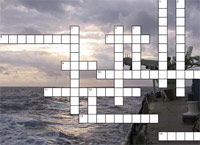|

 Today's Weather Mostly cloudy Lat: 04° 00’S Long: 12° 16’W Air Temp: 77.6°F Bar Pressure: 1008.9 mbar Sea Temp: 79.7°F Sea State: 4-6 ft Swell Height: <7 ft, SSE Wind: SSE; 13-15 knots Visibility: Unlimited
Puma on the Prowl Puma went exploring last night and today— but not where the team programmed it to go! Puma was launched on its second dive yesterday evening about 8 p.m. and, with the help of a drop (descent) weight, made it to the bottom. It took a break there while the corrodible link attaching the drop (descent) weight to the vehicle dissolved away. With its leash removed, Puma ascended to the survey depth ready to fly its mission. But then it had a problem. Puma was “pinging” to the two seafloor transponders (or sound beacons) and they were “pinging” back—but Puma was not “hearing” the pings coming from one of them. To determine its own location, Puma needs to hear “pings” from both transponders. That meant it could not figure out where it was, so it made an assumption as to its position and started heading off to find the survey area—but in the wrong direction! Early this morning, the engineering team tried sending “abort” commands to Puma, but it didn’t obey; the commands were not getting through. Finally, about 10:30 a.m. this morning, it “heard” the command, and started back to the surface. Puma popped to the sea surface early this afternoon, just where the engineers predicted it would. Chief Mate Adam Seamans skillfully maneuvered Knorr alongside and Puma was lifted back on board for a well-deserved rest and a battery recharge. Despite these navigation problems, Puma deserves a pat on the back. All of the sensors it uses to detect hydrothermal plumes had worked, and during its excursion, it had explored a region of cloudy water with a good Eh “hit.” Engineers are now back-tracking to find out the location of that “hit,” which may be in the originally planned survey area. And now it’s Jaguar’s turn to take a dive. But first, the engineers decided to send another transponder to the seafloor to make sure Jaguar would be able to “hear” at least two “pings,” and not get lost like Puma did. Jaguar might look just like its sibling, Puma, but its mission is different. Puma maps hydrothermal plumes that rise from seafloor vents and spread out like a cloud of smoke. It swims hundreds of meters above the seafloor and covers an area of perhaps 2 kilometers by 1 kilometer (1.2 miles by 0.7 miles). But Jaguar is the vehicle that likes to get “up close and personal.” It covers much smaller areas than Puma and flies much closer to the seafloor. It is also equipped with additional sonar and imaging equipment that collect very detailed information. After a ballast test this evening, we will send Jaguar down to conduct a survey in a much smaller area. Geophysicist Rob Reves-Sohn and geologist Susan Humphris worked with graduate student Chris Murphy to analyze the data collected from the CTDs and Puma, and define a small area to survey. Our plan is that Jaguar will dive down and swim about 25 meters (82 feet) above the bottom to collect high-resolution data to make a detailed map of the seafloor. Then it will drop down closer to the seafloor to use a camera and strobe light system that—we hope—will take the first images of the seafloor from this cruise, parts of the ocean depths never seen before. Read the new interview Adam Seamans: Adam Seamans, who grew up in Beverly, MA, is the Chief Mate aboard the Knorr. He talks about his career path and job responsibilities—including advice to anyone interested in working on a ship at sea! Read the interview »
[ Previous day ] [ Next day ]
|
||
Mailing List | Feedback | Glossary | For Teachers | About Us | Contact
© 2010 Dive and Discover™. Dive and Discover™ is a registered trademark of Woods
Hole Oceanographic Institution



